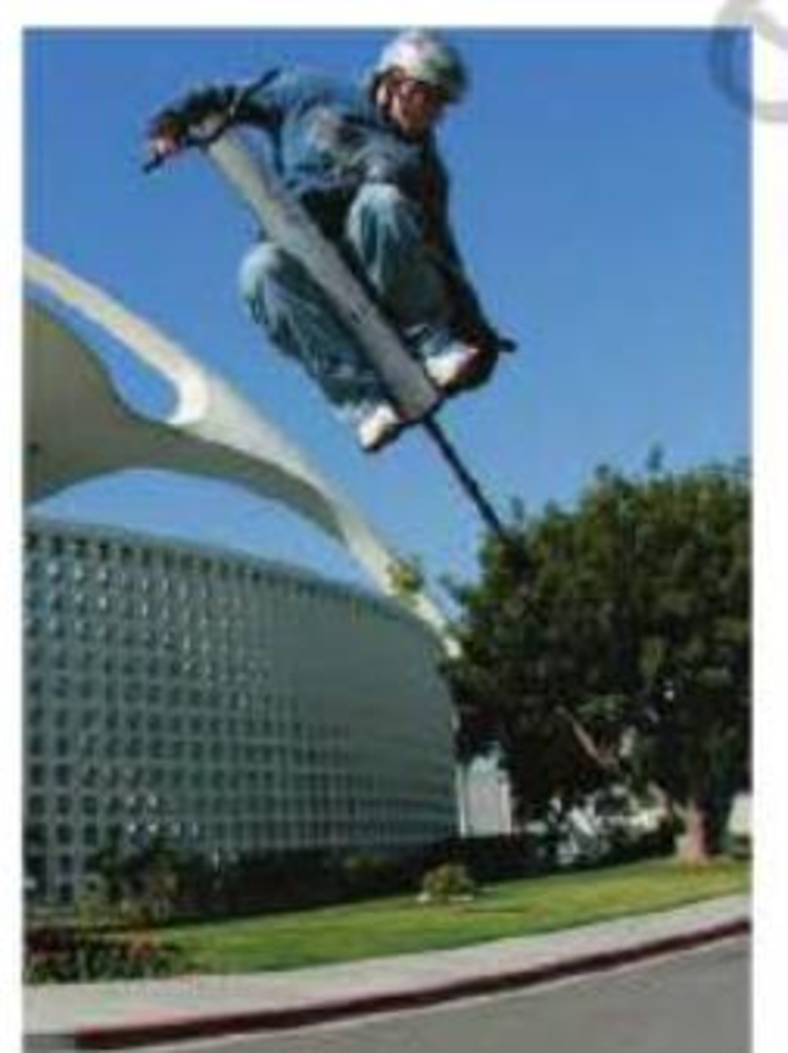
The following passages and associated questions are based on the material of Part II.
Big Air
A new generation of pogo sticks lets a rider bounce more than 2 meters off the ground by using elastic bands to store energy. When the pogo’s plunger hits the ground, the elastic bands stretch as the pogo and rider come to rest. At the low point of the bounce, the stretched bands start to contract, pushing out the plunger and launching the rider into the air. For a total mass of 80 kg (rider plus pogo), a stretch of 0.40 m launches a rider 2.0 m above the starting point.

If you were to jump to the ground from a height of 2 meters, you’d likely injure yourself. But a pogo rider can do this repeatedly, bounce alter bounce. How does the pogo stick make this possible?
A. The elastic bands absorb the energy of the bounce, keeping it from hurting the rider.
B. The elastic bands warm up as the rider bounces, absorbing dangerous thermal energy.
C. The elastic bands simply convert the rider's kinetic energy to potential energy.
D. The elastic bands let the rider come to rest over a longer time, meaning less force.
Want to see the full answer?
Check out a sample textbook solution
Chapter P Solutions
College Physics: A Strategic Approach (3rd Edition)
Additional Science Textbook Solutions
Cosmic Perspective Fundamentals
Physics for Scientists and Engineers: A Strategic Approach, Vol. 1 (Chs 1-21) (4th Edition)
Biology: Life on Earth (11th Edition)
Campbell Essential Biology with Physiology (5th Edition)
Human Biology: Concepts and Current Issues (8th Edition)
Chemistry: Structure and Properties (2nd Edition)
- Question 16 2.9 Three Pulleys 2.9a A thin, light rope is draped over three frictionless pulleys arranged around the origin as shown. Each pulley is a solid disk of radius r=2cm and is equidistant from the origin. 5kg mass is attached to one side and a 7kg mass to the other. Before the masses are released and in motion, what is the total angular momentum in kgm2/s around the origin? Question 17 2.9b What fraction of the angular momentum is in the pulleys?arrow_forwardAt what temperature would water boil if the outside pressure was only 19,900 Pa in degrees Celsius?arrow_forwardWhich of these properties of a sound wave is associated with the pitch of the sound that we hear? amplitudefrequency intensity levelintensityarrow_forward
- A wave travels upward in a medium (vertical wave velocity). What is the direction of particle oscillation for the following? (a) a longitudinal wave parallel to the direction of propagationperpendicular to the direction of propagationarrow_forwardThe faster a molecule is moving in the upper atmosphere, the more likely it is to escape Earth's gravity. Given this fact, and your knowledge of rms speed, which of the following molecules can escape most easily from Earth's atmosphere if they are all at the same temperature?arrow_forwardThe temperature in one part of a flame is 2,100 K. What is the rms velocity of the carbon dioxide molecules at this temperature? Give your answer as the number of meters per second. mass of 1 mole of CO2 = 44.0 grams 1 mole contains 6.02 x 1023 molecules the Boltzmann constant k = 1.38 x 10-23 J/Karrow_forward
- The specific heat of a certain substance is 375 J/(kg°C). How much heat energy would you have to add to increase the temperature of 22 kg of this substance from 33°C up to 44°C in a number of Joules?arrow_forward3.9 moles of an ideal gas are sealed in a container with volume 0.22 m3, at a pressure of 146,000 N/m2. What is the temperature of the gas in degrees Celsius?arrow_forwardwhen a cannon is launched at a 65 degree angle, will it have the same horizontal velocity as when it is launched from a 25 degree angle as long as the initial speed is the same?arrow_forward

 Glencoe Physics: Principles and Problems, Student...PhysicsISBN:9780078807213Author:Paul W. ZitzewitzPublisher:Glencoe/McGraw-Hill
Glencoe Physics: Principles and Problems, Student...PhysicsISBN:9780078807213Author:Paul W. ZitzewitzPublisher:Glencoe/McGraw-Hill Physics for Scientists and Engineers: Foundations...PhysicsISBN:9781133939146Author:Katz, Debora M.Publisher:Cengage Learning
Physics for Scientists and Engineers: Foundations...PhysicsISBN:9781133939146Author:Katz, Debora M.Publisher:Cengage Learning Principles of Physics: A Calculus-Based TextPhysicsISBN:9781133104261Author:Raymond A. Serway, John W. JewettPublisher:Cengage Learning
Principles of Physics: A Calculus-Based TextPhysicsISBN:9781133104261Author:Raymond A. Serway, John W. JewettPublisher:Cengage Learning College PhysicsPhysicsISBN:9781938168000Author:Paul Peter Urone, Roger HinrichsPublisher:OpenStax College
College PhysicsPhysicsISBN:9781938168000Author:Paul Peter Urone, Roger HinrichsPublisher:OpenStax College Physics for Scientists and Engineers, Technology ...PhysicsISBN:9781305116399Author:Raymond A. Serway, John W. JewettPublisher:Cengage Learning
Physics for Scientists and Engineers, Technology ...PhysicsISBN:9781305116399Author:Raymond A. Serway, John W. JewettPublisher:Cengage Learning





